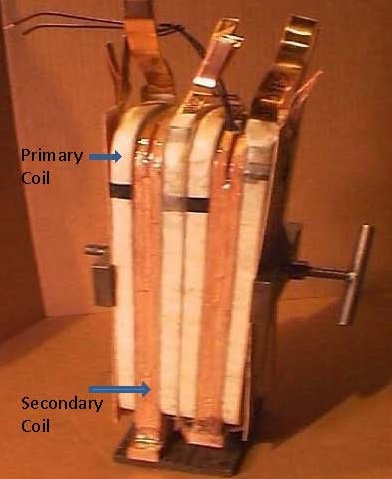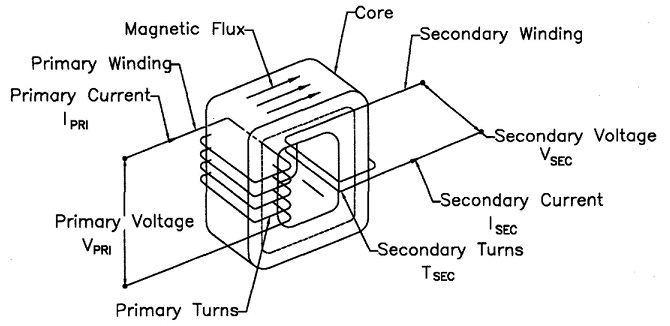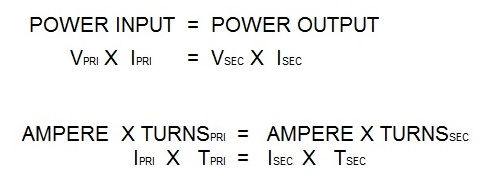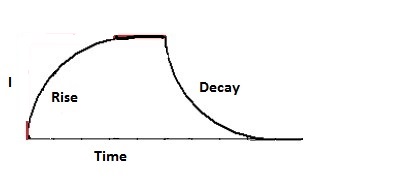
Controls & Transformers
Questions and Answers
Hanging transformers are used with portable weld guns. They generally have long conductors to the guns. The transformers tend to be large to drive the power over these long cables.

PORTABLE GUN & TRANSFORMER
The question is what type of core material is suitable for a hanging transformer. This is a machine design question and is beyond the scope of this forum.
Consult a transformer manufacturer for additional information.
Resistance welding transformer primaries are wound with many turns in order to produce the desired turns ratio. This in turn produces the conversion of the high voltage and low amperage in the primary to the desired low voltage and high amperage in the secondary. The winding material is copper and is required to conduct both current and heat at the amperage the transformer is designed for.

SUBASSEMBLY OF A TRANSFORMER
Calculation of the winding gauge size is a manufacturing question and is beyond the scope of this forum.
Contact a resistance welding transformer manufacturer for additional assistance.
The turns ratio for all resistance welding transformers is calculated in the same manner no matter the KVA size. Turns ratio is the ratio of the number of coil turns in the primary vs the secondary.

In AC transformers, there are many turns in the primary. The secondary has one turn. If there are 50 turns then the ratio is 50/1. Therefor the primary voltage will drop from 220 V and 100 amp input to 220/50 = 4.4 volts in the secondary. The equations for this are:

Vpri = Voltage on the primary Tpri = Turns in the primary coil
Vsec= Voltage on the secondary Tsec = Turns in the secondary coil

Power into the transformer will equal power out of the transformer.

Isec = Secondary amperage
Ipri = Primary amperage
In the secondary using the above formula:
If the Ipri = 100 amperes
If the turns ratio = 50/1
Isec = (Ipri X Tpri)/ Tsec
Isec = 100 x 50/1
Isec = 5000 amperes
There are several additional articles written on turns ratio available in the “HOW TO RESISTANCE WELD” website. Enter “Turns Ratio” in the search box on the home page for additional information.
Reference: RWMA Manual Chapter 19
With MFDC and DC one generally considers the reactive impedance as very small in resistance welding. This is correct once the current is at steady state. Impedance is a combination of reactance and resistance in the welding circuit. In MFDC and DC the reactance during a weld is minimal as compared to a 60 Hz AC weld. However thare are still some effects of inductance that play a part in MFDC and DC resistance welding. Inductance is a property of a conductor that resists the change in current over time. This occurs at the beginning and end of a weld, when the current starts and stops flowing.
In the initial and final cycles when the current is changing, inductance does have an effect upon the process of MFDC. As the weld initiates the control measures the current each half cycle and realizes that it did not reach its desired current due to the inductance. The control will fire at full conduction during this time. This repeats until the desired current is reached. This is called rise time and is 3-8 milliseconds for MFDC. At this point the current is at steady state and the inductance goes to zero and the current levels off until the control turns the current off. When the control turns off, the inductive energy that was stored in the circuit will now bleed off. There will be a decreasing current flow until all is bled off. This is called decay time and is about 3-8 milliseconds.
DC equipment which operated at 60 HZ operates similarly but will have a different curve and take longer to reach steady state.
Plots of the output curves of both MFDC and DC will exhibit small ripples. These ripples reflect the electrical sine wave which has been rectified to 1000 HZ or 60 HZ.

RED REPRESENTS NO INDUCTIVE LOSSES
BLACK SHOWS THE RISE AND DECAY RESULTING FROM
INDUCTIVE LOSSES
These inductive losses can be compared to a fly wheel. To get it started, extra energy must be put into the flywheel to get it turning, rise time. Once the target speed is reached no extra energy is required. It will continue at speed. When it is time to stop the energy of the spinning wheel must be removed to stop the wheel, decay time.
As discussed MFDC and DC will have different rise and decay curves.
Each welder potentially will have a different inductive load.
Reference: RWMA – Resistance Welding Manual 4th Edition
AWS – Welding Journal, Q & A, July 2019
With MFDC and DC one generally considers the reactive impedance as very small in resistance welding. This is correct once the current is at steady state. Impedance is a combination of reactance and resistance in the welding circuit. In MFDC and DC the reactance during a weld is minimal as compared to a 60 Hz AC weld. However thare are still some effects of inductance that play a part in MFDC and DC resistance welding. Inductance is a property of a conductor that resists the change in current over time. In MFDC and DC this occurs at the beginning and end of a weld, when the current starts and stops flowing.
Page 13 of 39
Have a Question?
Do you have a question that is not covered in our knowledgebase? Do you have questions regarding the above article? Click here to ask the professor.
